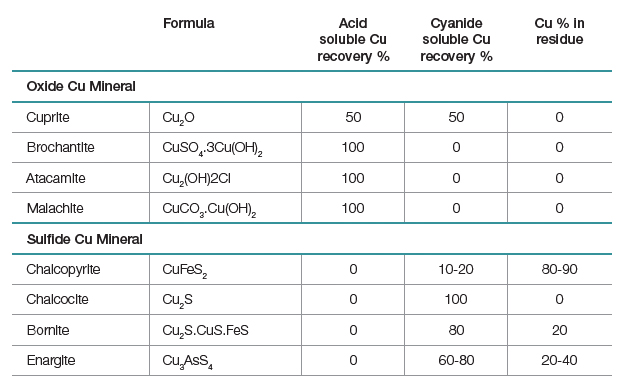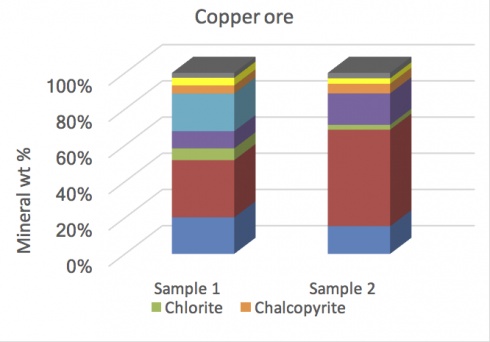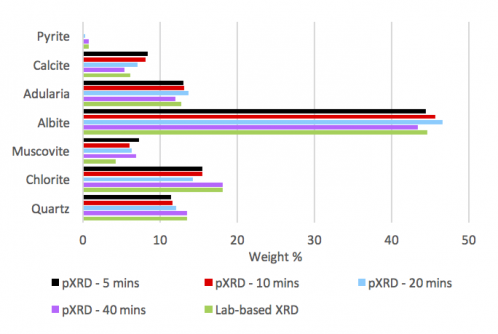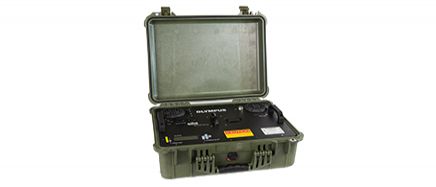Mining operations use a combination of metallurgical processes for mineral extraction. This often involves flotation to produce a mineral concentrate followed by smelting or leaching to recover the final product(s). Knowing the quantitative mineralogy at each of these stages is important to optimizing the effective and efficient recovery of a valuable mineral deposit. Quantitative mineralogy enables more productive process strategies (e.g. blending) and ongoing process optimization. Metallurgists and geologists typically use chemical assay data to estimate quantitative mineralogy, but due to inherent mineralogical complexity, these estimates can be misleading. Olympus portable X-ray diffraction (pXRD) analyzers can provide the metallurgist with reliable quantitative mineralogy onsite, in near real-time, that would otherwise take days or weeks to obtain.
Flotation
Flotation is a common process used to concentrate a variety of base and precious metal ores. During flotation, the ore is treated with reagents (chemicals) to encourage the valuable sulfide minerals to float and suppress the non-valuable minerals. Unfortunately, not all of the economic elements are contained within sulfide minerals (e.g. they may exist in oxides) and non-valuable gangue minerals can also float (e.g. talc and clays), contaminating and lowering the concentrate quality.
Using Olympus pXRD systems, metallurgists, geologists, and mining engineers can:
- Quantify problematic and deleterious minerals (e.g. talc and clays) that contaminate and downgrade concentrates (Figure 1)
- Quantify the proportion of economic minerals that will float (e.g. sulfides)
- Tailings rheology (de-watering, environmental)
Leaching
Metals cannot be leached from all ore-bearing minerals, and ore minerals that can be leached have different leaching potential/leaching rates. In addition, gangue minerals also consume acid during the leaching process. Olympus pXRD can be effectively utilized to:
- Estimate recoverable metal
- Select the most approximate leaching method to optimize value (Figure 2)
- Understand acid consumption, a key cost
 |
| Figure 2. The behavior of different Cu ore minerals with leaching methods. By understanding ore mineral assemblages, the metallurgist can use more appropriate leaching methods or have more realistic estimates of expected recoveries (after Jansen & Taylor 2003). |
Pyrometallurgy (Smelting and Roasting)
The mineralogical composition of concentrates has a large impact on subsequent pyrometallurgical processes that can involve smelting and or roasting the mineral concentrate product. Quantitative mineralogy obtained from Olympus pXRD analyzers enables metallurgists to:
- Optimize their processing conditions
- Further treat or blend ore prior to smelting
- Classify matte and slag (waste) products
Rapid Quantitative Mineralogy — A Valuable Metallurgical Tool
Quantifying minerals that are problematic for metallurgical processes can be far more important than recognizing problematic minerals. These problematic gangue minerals often have minimal or manageable adverse effects at or below certain thresholds (or tipping points, Figure 3). For this reason, it is important for the metallurgist to have ready access to accurate quantitative mineralogical data (Figures 4 and 5) so they can optimize their process accordingly or develop more appropriate blending strategies.
 |
| Figure 3. By quantifying problematic gangue minerals, the metallurgists can determine how to best manage their metallurgical process or develop more appropriate blending strategies. |
Benefits of Olympus pXRD
The benefits of Olympus’ innovative pXRD analyzers include:
- Small sample: requires only 15 mg of material
- Easy sample preparation: instrument operation and data acquisition do not require a skilled technician
- Fast acquisition time: obtain results in few minutes
- Portability: rugged design with no moving parts
- No ongoing servicing requirements: XRD can be performed regularly with minimal downtime and in remote locations






